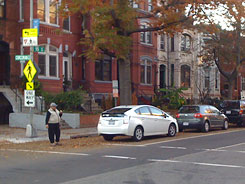Time, vigilance will work out the bugs in the 15th Street lane
Press coverage of the 15th Street bike lane has moved beyond the “people are confused” frame to “let’s see how this works.” That’s the right attitude.
As I’ve written so many times before, there’s no substitute for actual, on-the-ground experience to find the best ways to move pedestrians, bikes and cars safely and fairly. In addition to Ashley Halsey’s excellent article, WashCycle points to a good Tom Sherwood piece on the lane.
Some cyclists aren’t so pleased. Dr. Gridlock prints one cyclist’s letter saying that turning cars don’t look enough, there are too many leaves, and cars and trucks double park where they shouldn’t. Gridlock counsels some patience, and WashCycle rebuts some of the points, especially the one about leaves, which are getting everywhere, lane or no lane, and will soon be over. Contrary to some claims, DPW is indeed able to get a sweeper truck in there.
It does appear that some drivers are parking in the visibility zones, however. That’s a real problem, because the visibility zones are key to keeping left-turning drivers from hitting cyclists. Reader Michael sent in these pictures of cars parked there over the weekend:




Just as the other issues warrant patience, so should this. DDOT can work with DPW and MPD to ensure drivers who park there get tickets. If they do, drivers will learn not to park there. I do wonder why there aren’t flexposts placed to block parking in this zone. If parking in visibility zones remains a problem, DDOT could consider adding them.
As for that mail truck, we do need to enable mail trucks to park briefly to deliver the mail, as well as delivery trucks and even cars stopping momentarily to unload groceries. Right now, many of the spaces in front of fire hydrants and at corners serve as de facto temporary loading zones. In the future, as DC installs more bike lanes and bulb-outs, those loading zones will go away. The best solution would be to create official 15-minute loading areas where appropriate, instead of simply assuming that pedestrian and bicycle safety has to suffer to let people reasonably load and unload.
